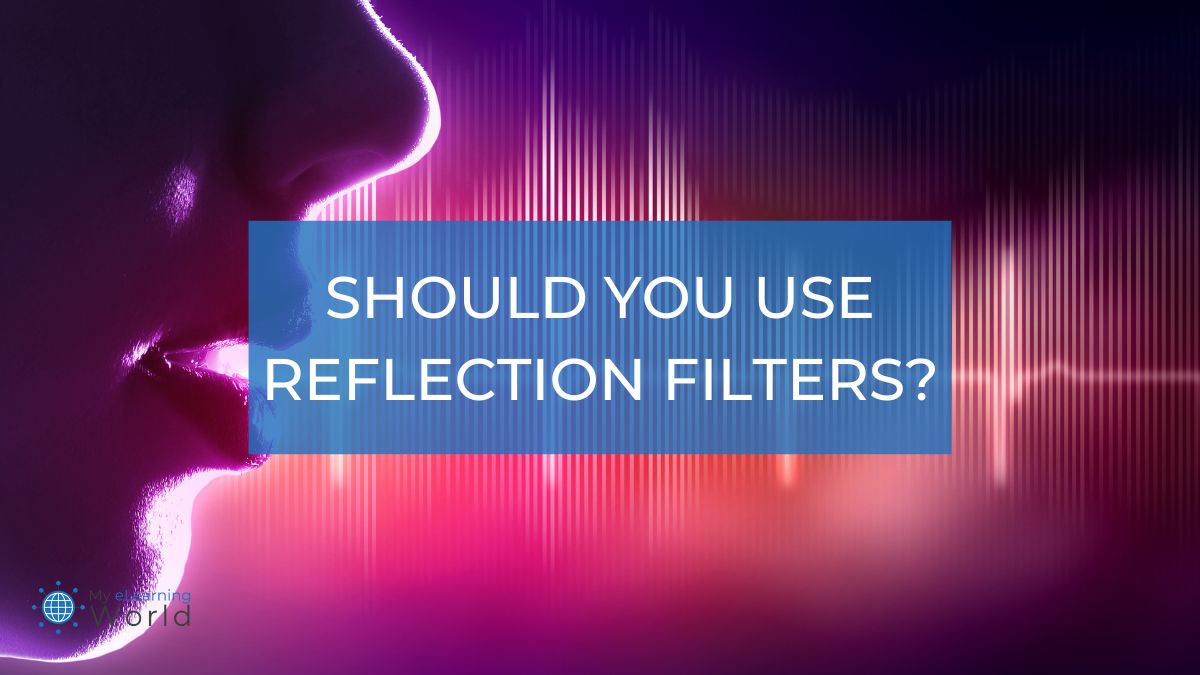Whether you’re recording in a high-end studio, podcasting from the comfort of your living room, or narrating eLearning courses in your home studio, creating the right recording environment is essential for achieving a quality final product. As an instructional designer with years of experience recording various projects in my own home setup, I want to talk about one of my favorite tools for controlling the sound in my studio — microphone isolation shields and reflection filters.
Pairing a reflection filter with my voiceover mic ensures my recordings are crisp and free from annoying background noises. It’s made editing a breeze, letting me polish my audio until it shines.
But here’s the thing — while I love isolation shield and reflection filters, there are times where you should use them and other times where you might not want to. Before choosing any type of microphone isolation shield or reflection filter, it’s important to understand how they work and why they’re used.
Here are some things to consider before you start shopping for microphone isolation shields.
When to Use a Microphone Reflection Filter
Any time sound is produced, whether it be from a voice, an instrument, or a car door slamming, a pressure wave is created. This wave travels through the air and reverberates within the eardrum, thereby creating what we know as sound.
However, sound waves don’t just hit our eardrums in a straight line.
Instead, sound waves spread out and bounce off of nearby surfaces.
Depending on the material of these nearby surfaces, reflections are created just like a mirror. This is what creates reverb and echo or delay effects.
The harder and more even a surface is, the more likely it will be to produce a strong reflection that can feed back into your microphone, ultimately leading to unwanted noise.
In order to get rid of these unwanted reflections, I use a mic reflection filter when recording. Microphone isolation shields act as a barrier between my voice and any reflective surfaces while recording.
Because these types of filters utilize dense, uneven materials, they don’t reflect sound well, meaning the microphone receives a clear, direct sound wave from my voice without the clutter of reflective reverberation and echo.
I almost always use a microphone reflection filter when recording voice over work because I need to not only have clear audio, but I also need to be able to shape the sound in post-production.
The best part is that, by recording a dry signal, I can add or remove reflections later through my editing software and plugins.
When Not to Use a Microphone Isolation Shield
While I love using reflection filters and do so very often, there are some situations where I actually want to record reflections.
These situations may arise when I’m trying to capture the acoustic space of a room for effect during recording.
For example, if I’m recording a voice over that needs to sound like I’m in a large auditorium, I would set up my recording rig in the space and allow the reflections to naturally bounce back to the mic off of the walls and other surfaces.
I might also forgo the use of a microphone reflection filter or mic shield when I’m in a live recording environment and need to capture the crowd and other audio sources around the area.
If I place a microphone isolation shield around the microphone in these situations, then I can lose the natural ambiance of the moment, but without one, those room reflections won’t get lost or muted.
Final Thoughts
Reflection filters and isolation shields can be helpful tools for any audio recording enthusiast, from the seasoned professional to the home studio hobbyist. They offer a simple way to control the sound quality of your recordings, so that what you capture is as close to your vision as possible.
But like any tool in the world of audio production, knowing when and how to use them is key. For most of my voiceover work, the clarity and control offered by a reflection filter are non-negotiable. But every once in a while, embracing the natural acoustics of a space can sometimes bring a recording to life in ways that isolation simply cannot match.
Remember, the goal is always to serve the story or message you’re trying to convey. With the right approach and a bit of experimentation, you’ll find the perfect balance for your audio recordings, making every project sound its best.

